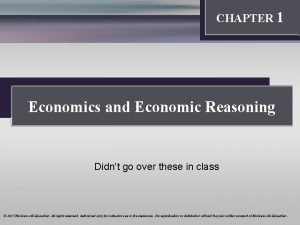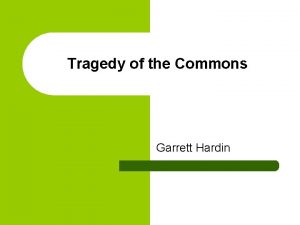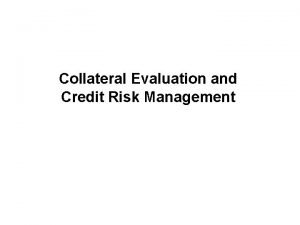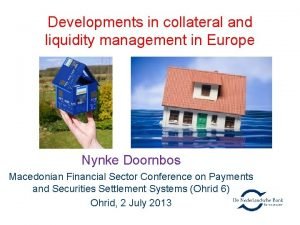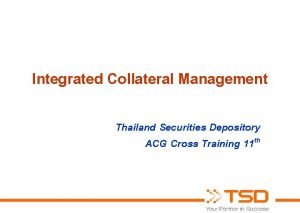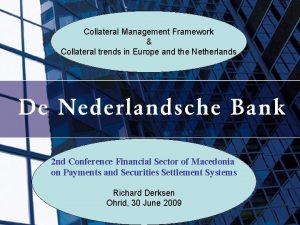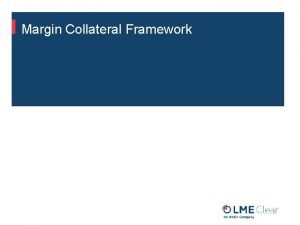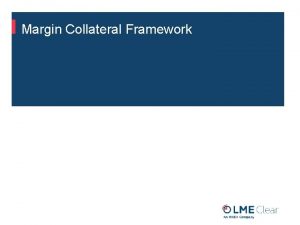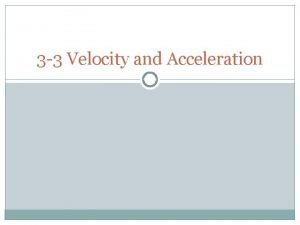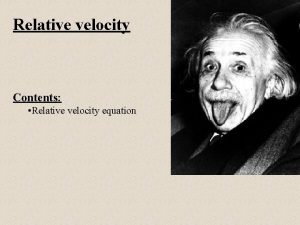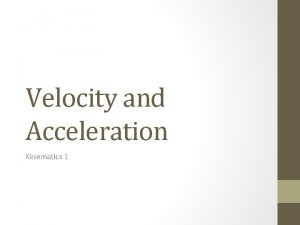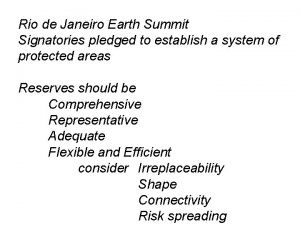Velocity of Pledged Collateral Manmohan Singh Senior Economist




































- Slides: 36

Velocity of Pledged Collateral Manmohan Singh Senior Economist, International Monetary Fund Views are of the author only and not attributable to the IMF

Collateral and Money n A great deal of short-term financing is generally extended by private agents against financial collateral. n Analogous to the traditional money-creation process. The use and re-use of pledged financial collateral facilitates financial transactions and contributes towards the supply of credit to the real economy. n Collateral is like high-powered money where the haircut is like the reserve ratio, and the number of re-pledging (the ‘length’ of the collateral chain) is like the money multiplier. The aggregate volume of re-pledged collateral reflects both the availability of collateral as well as the re-use rate of source collateral.

The suppliers of collateral to the ‘street’(or dealers) n The key sources that provide collateral to the street are (a) hedge funds, (b) custodians, generally on behalf of pension, insurers, asset managers, official sector accounts ( SWFs, central banks etc ). n Generally, hedge funds are the largest supplier of collateral to the “street” that intermediates the bank/nonbank nexus. n Others such as pension funds, insurers, official sector accounts generally “lend” their collateral for short tenor to enhance the overall return to their securities.

Pledged Collateral—US banks

Pledged Collateral—European banks (plus Nomura)

Total pledged collateral—all banks

Collateral from Hedge Funds largely finance their positions in two ways. n First, they can either pledge collateral for reuse to their prime broker in lieu of cash borrowing/leverage from the PB (rehypothecation)--usually for equity-related strategies < In the U. S. , SEC’s Rule 15 c 3 a and Regulation T generally limits PB’s unlimited use of rehypothecated collateral from a client>. Non US jurisdictions such as UK via English Law do not have any limits. n Second, HFs also fund their positions via repo(s) with dealers who may or may not be their PBs. Typically, fixed income arbitrage and global macro strategies seek higher leverage and this is done via repo financing.

The “non-hedge fund” source of collateral—declining due to counterparty risk etc

Securities Lending—another primary source of collateral n We distinguish between primary sources of securities lending rather than the total securities currently “on loan”. n We use RMA’s data source , which includes only primary sources of securities lending from clients such as pension, insurers, official sector accounts (SWFs etc. , ) and some corporate/money funds. n Securities lending vs. repo transaction : In terms of legality, in a repo there is an outright sale of the securities accompanied by a specific price and date at which the securities will be bought back. On the other hand, securities lending transactions generally have no set end date and no set price—so more flexible and usually used



An example of repeated use of collateral (that leads to collateral chains)

Collateral Re-use— see last column (figures are in trillions!)

Are there any other buckets that are sources of pledged collateral – Tri Party Repo or SIVs n The tri-party repo market ($1. 7 trillion) in the US is via 2 clearing banks, Bo. NY Mellon and JP Morgan. Though not explicit, a backstop by the Fed is assumed by the market. Similar sized market in Europe also, but Euroclear/Clearstream do not provide intra-day credit n However, such pledged collateral sits with custodians and is not rehypothecable to the street. —only to the primary dealer club! The collateral is segregated and identifiable in case of default of the collateral provider. This also explains that haircuts during the 2008 crisis were minimal when dealing within the tri-party system, relative to the ‘street’. n SIVs-- these structures were securitization-based and against specific pieces of collateral, ; thus it was difficult to raise funding by pledging

Overall Financial Lubrication-Money and Collateral

Price of Money vs. Price of Collateral n Central banks can create money by fiat; but not collateral (although there are now suggestions to produce “safe assets” as public good) n Money’s price is mapped by interest rate; collateral price (by repo rate –e. g. , general collateral (GC) etc. n The banking system in not presently mobilizing their deposits at central bank (in the form of “excess reserves”). In the US this is due to IOER (interest on excess reserves —see next slides). If this is the “price of money” the banks hold on to it and this does not reach the financial system then the price of money is high relative to other assets. If banks are not lending “excess reserves”, the only way n

n n Why does price of good collateral vary Financial lubrication takes the form of "cash or cashequivalent" for margins etc. so a choice to post money or good collateral. In short, the "price" of good EU collateral (ie repo rates for short tenor German/French/Dutch or related Danish/Swiss bonds ) remains low (and even negative) relative to US Treasury bills repo. n Part of this is explained through the usual technical issues (home bias, fx hedge, size/liquidity of EU debt markets, peripheral Europe issues. ; cheapest to deliver); or policy actions like Operation Twist for T-bills (that buoyed the repo rate in the US). n Price of money--the IOER of 25 basis points-- in the US

US money (IOER) and collateral (GC) rates

ECB Deposit Rate and (good)EU collateral

Dutch Repo rates Source: Icap

Monetary Policy Rate (IOER) in the medium/ long run—as projected by Fed’s paper (baseline)

Academic/some loose thoughts… Collateral in IS/LM framework

IS/LM and pledged collateral market crash; IS shifts “in” sizably; LM shifts “out” via QE etc

Rates without Fed balance sheet adjustment would be lower http: //www. newyorkfed. org/newsevents/speeches/2012/dud 120524. html

The changing collateral space— from “old” to the “new” era In the “new” collateral space, the increasing role of central banks regulations, and collateral custodians is significantly changing the collateral landscape. n (i) unconventional monetary policies pursued by central banks n (ii) regulatory demands stemming from Basel III, Dodd Frank, EMIR etc that will entail builder collateral buffers at banks (LCR), CCPs etc; n (iii) collateral custodians who are striving to connect with the central security depositories (CSDs) to break out of silo(s). n (iv) supply of new collateral (assume D/GDP ratio does not increase significantly in developed countries).

This is what we saw earlier…


Regulations---example from Non-cleared OTC Derivatives—$10 trillion estimate below is via a draft ISDA study. First column does not allow netting


ECB balance sheet is 1 trillion higher (relative to end-2011) —and still holds good collateral that can be rented. Reserve Bank of Australia example (last slide)


Net supply of AAA/AA new debt issuance source: Barclays index/JPMorgan/RMA n Supply of AAA/AA expected has averaged 1 trillion (includes sovereigns + corporates). Markets move AAA very easily and this helps also move other “not-so-good” highly rated collateral. n Equities are also moved by markets n However only a fraction 30% to 40% of AAA/AA securities are used in securities lending programs (source RMA database) n If collateral re-use (say, velocity of 2. 5) does not decline,


Collateral Transformation n Collateral transformation---can involve bonds or equities —as long as it has a market clearing price and not illiquid (e. g. , US Treasuries, IBM shares etc). n Collateral movement is “opening the silos”– the custodian do not own the collateral but may facilitate client’s connectivity (collateral highway for transformation). Euroclear/ Clearstream/ Bo. NY and JPMorgan may be able to better optimize available collateral that does not move at present n Dealers are also interested in collateral transformation. However transforming a BBB to AA from off balance sheet—via pledged collateral -- may get caught via (new)

n Custodians, Dealers & Collateral Silo(s) Eurozone had € 14 trillion in collateral– (i) much of it was locked in “depositories" and thus not easily accessible for cross border use or(ii) the asymmetry of demand for collateral in ‘peripheral’ countries relative to ‘core’ countries did not make the € 14 trillion figure meaningful. n However, Euroclear and Clearstream (the key hubs for Eurozone collateral) are working with the local CSDs (or national/central security depositories) to alleviate collateral constraints. The interconnections to the CSDs will be via the Target 2 Securities (T 2 S) system that will provide a single pan. European platform for securities settlement in central bank money. n In the US, JPMorgan and Bo. NY may also improve collateral

Some policy observations The re-use of collateral is fundamental in understanding the gap between demand supply. Reserve Bank of Australia’s suggestion is similar to collateral transformation but at a penalty rate (about 15 basis points plus appropriate haircut) by using good assets from their own balance sheet, but this would keep collateral re-use rate high. Demandcollateral = Supplycollateral *re-use factor n n Central banks may want to "rent" the good collateral they hold, especially if their goal is to keep the good/bad collateral ratio high “in the markets”. Suggest academic thinking— Gourinchas/Jeanne(BIS). . of making supply/shortage of “safe assets” as a public good. n Keeping good collateral in market (and thus high collateral reuse
 Property pledged to assure repayment of a loan
Property pledged to assure repayment of a loan Lovejoy murder
Lovejoy murder Sarwan singh kundan singh
Sarwan singh kundan singh Angular velocity to tangential velocity
Angular velocity to tangential velocity Permeability formula
Permeability formula Speed unit
Speed unit Angular acceleration formula with radius
Angular acceleration formula with radius Relation between linear velocity and angular velocity
Relation between linear velocity and angular velocity Instantaneous velocity vs average velocity
Instantaneous velocity vs average velocity Initial velocity and final velocity formula
Initial velocity and final velocity formula Darcy's law
Darcy's law Final velocity initial velocity acceleration time
Final velocity initial velocity acceleration time Thinking like an economist chapter 1
Thinking like an economist chapter 1 Chapter 2 thinking like an economist
Chapter 2 thinking like an economist A wise economist asks a question
A wise economist asks a question Implied stipulation
Implied stipulation Hardin economist
Hardin economist Lpc collateral
Lpc collateral Van essen
Van essen Collateral estoppel definition
Collateral estoppel definition Economist china trade
Economist china trade Triparty collateral management
Triparty collateral management Thinking like an economist ppt
Thinking like an economist ppt Collateral evaluation
Collateral evaluation Collateral and liquidity management
Collateral and liquidity management Sample of collateral reading
Sample of collateral reading Jane carter labor economist
Jane carter labor economist Eoc a sample
Eoc a sample Function of arterioles
Function of arterioles Thinking like an economist chapter 2
Thinking like an economist chapter 2 Canal brachial
Canal brachial Collateral management
Collateral management Character capacity collateral
Character capacity collateral Thinking like an economist chapter 2
Thinking like an economist chapter 2 Navy eval closing statements early promote
Navy eval closing statements early promote Brachial artery
Brachial artery Tradegy of the commons
Tradegy of the commons












